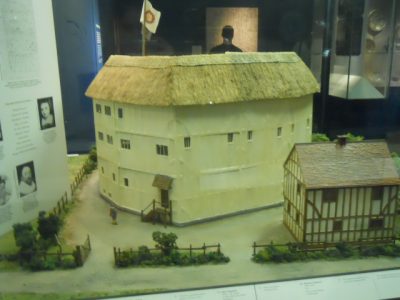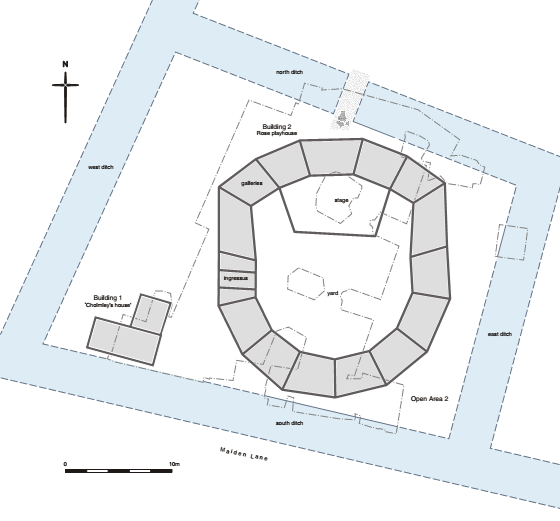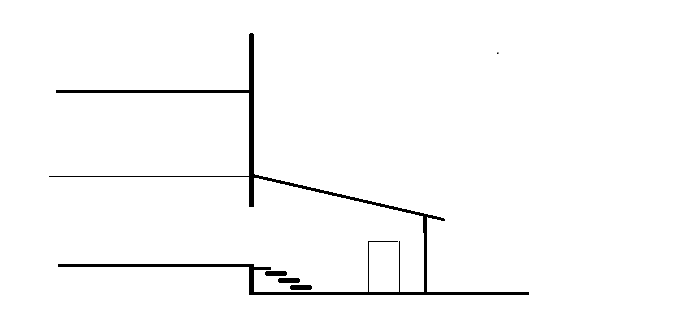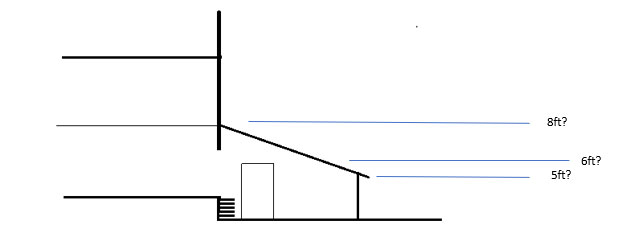The penthouse shed, Phase II © De Montfort University, Leicester, UK. To view the image using Google Cardboard, click here.
In his accounts, Henslowe’s diary (MSS VII f. 5v) records the following item:


Henslowe’s frequent use of a brace or curly bracket to indicate payments for particular items appears to indicate that those items listed below in his account are unconnected to the building of the penthouse shed:
Pd for bordes & quarters……………………………xviijs vj
Pd for bordes …………………………………………….xiijs vjd
Pd for naylles & henges & bowlltes………….xixs
Pd the carpenters for wages ………………………ixs
Wickham draws attention to Henslowe’s accounts for this payment but makes no comment on it.350 However, in English Professional Theatre, 1530–1660, Wickham, Berry and Ingram alter Henslowe’s layout so that proceeding his statement ‘Paid for making the penthouse shed at the tiring-house door as followeth:’ they remove the curly bracket and indent a list all of the items indicating to the reader their assumption that all were involved in the shed’s construction.351
Assuming an average wage for a carpenter of 8d per day in 1592,352 Henslowe’s payment of 9s would pay for one carpenter for 13.5 days labour, and more than one carpenter (Henslowe’s accounts lists them as plural) for fewer days.
Rhodes concludes that ‘the expenditure of seventy shillings for such items as “owld tymber,” “bordes and quarters,” and “naylles & henges & bowlltes,” and wages for carpenters for approximately nine days work’ indicates that something more substantial was involved. He considers Henslowe’s reference to ‘penthowsse shed’ to refer to the roof over the stage—‘the platform supporting the heavens or the “cover” over the stage,’ where ‘at the tyeringe howsse doore’ refers to the opening onto the stage—rather than ‘an awninglike structure immediately above a door leading into the tiring-house from outside the theatre (because it isn’t shown on Norden’s images of the Rose).’353
However, Henslowe is actually referring to a lean-to with sloping roof constructed as an annex to the back of the playhouse. Penthouse stems from Middle English, ‘Pentis,’ from the Old Fr., apentis or ‘an attached building; appendage’ (from L., ‘appendere,’ meaning ‘to hang on/against; attach’). The change of form in the sixteenth century was by association with Fr. pente ‘slope’ and house to mean ‘a secondary shed (with a sloping roof?) attached to the wall of a larger primary building.’ (The current sense of ‘apartment or dwelling on the roof’ or ‘at the top of’ a building dates to the 1920s.) The OED defines ‘shed’ as ‘A slight structure built for shelter or storage, or for use as a workshop, either attached as a lean-to to a permanent building or separate; often with open front or sides.’ It defines ‘penthouse’ (as a ‘pre-fix’) as a ‘subsidiary structure or annexe attached to a wall of a main building, such as a shelter, a porch, a shed, an outhouse, etc.’ with the following subdivisions:
(a.) A structure extending from the side of a building and having a sloping roof, sometimes forming a covered walk between buildings; such a structure in front of a building or row of buildings, forming an arcade, colonnade, veranda, etc. Also: a sloping roof or ledge placed against a wall or over a door or window to provide shelter from the weather; sometimes also applied to the eaves of a roof when projecting considerably. Now chiefly historical. (b.) Without reference to a sloping roof: any smaller building attached to a main one, an annexe.
Empson concludes that the penthouse shed was a structure ‘put over the stage door at the back’ of the tiring house. He thinks it was—a wooden awning designed to provide cover for the person who had ‘now to sit there all the time, ready to take money and do the honours’ to the richer patrons who used the rear entrance to the tiring house as access in order to avoid the commoner sorts of playgoers using the main entrance on Maiden Lane.354 C. Walter Hodges’ illustration for Phase II shows only the front and side elevation (see fig. 92 [5.8.5]), although the model of Phase II at the Rose exhibition (built by Museum of London from Hodges’ illustrations) includes the type of wooden awning Empson was suggesting overhanging the rear door to the tiring-house (see fig. 99).

What is not clear from Henslowe’s account of his spending on the shed is how substantial the shed was, which might have been anything from a sloping roof over a doorway acting as a shelter to a small room or lean-to annex. It is not possible to know what kind of deal Henslowe struck for the ‘owld tymber’ or how much he managed to purchase for twenty shillings; according to his own accounts, in 1595 Henslowe purchased three long pieces of timber for 6 shillings and one long piece of timber for 16 shillings.355 According to one study, the average price of timber in 1592 was 3.31 shillings per ft3, so 10 shillings might have bought Henslowe approximately 3ft3 of new timber on average—certainly enough to construct a wooden awning over a door—and presumably if it was ‘old’ he got more of it for his money.356
Bowsher and Miller note that the limits of the excavation meant that the full shape of the northern end of the building, particularly the northern exterior to the building, was not revealed and no trace of the ‘penthowsse shed’ survived in the archaeological record.357 Bowsher thinks it seems likely the addition of the lean-to was to extend space in the tiring house for storage (Henslowe’s inventory of props is extensive) as well as space for performers to attire themselves, etc.358 The addition of the penthouse shed begs the question why, having just laid out a huge sum of money to redesign and reconstruct the playhouse a great effort, Henslowe hadn’t factored in these requirements, and instead added a lean-to from old wood.
If the structure was more substantial than simply a sloping wooden awning atop a doorway for shelter, it was unlikely to have been built directly to the rear of the building because of the relatively little space between the northern point of the playhouse and the boundary ditch to the north (see fig. 100). Anything substantial seems most likely to have been constructed to the northwest—where the model built by the Museum of London positions a rear entrance. The area to the northeast corner of the plot has never been fully excavated so it’s not known what structures lie there, but the space and access is limited by the north and east boundary ditches, and so seems an unlikely place to choose to append structures such as a lean-to shed to the playhouse.
Fig. 100: Diagrams showing the extent of the excavated remains of the Phase II playhouse in the north and the proximity of the (presumed) north wall of the building with the boundary ditch to the north © MOLA359
The likely position of the penthouse shed also depends on what Henslowe meant by ‘at the tiring house door,’ and whether this should be taken to refer to somewhere ‘near’ or ‘next to’ the doorway or ‘directly attached to’ it. (In terms of its use to determine local position, answering the question ‘where?,’ the OED I.1a. defines ‘at’ [prep.] as ‘usually determining a point or object with which a thing or attribute is practically in contact, and thus the place where it is, when this is either so small as to be treated as a mere point, or when the exact relation between the thing and he place is not more particularly expressed by the preposition close to, by, about, on, in, over, under, etc., all of which mat at times be covered by at.’)
One possibility for the position of the penthouse shed is that it was built attached to and extending directly out from the rear entrance, be it positioned directly north facing the causeway or to the northwest where there was more room (fig. 101). However, in this position its relationship to the entrance and its function is unclear. If the rear of the tiring house was used as a private entrance for richer patrons, either they were expected to walk through the shed (unlikely if it was intended for storage or as a ‘green room’ for players?) or there was more than one rear entrance.
Fig. 101: The penthouse shed positioned connected to the tiring house door360
Alternatively, we might assume Henslowe was using the preposition to state that the shed was ‘next to’ or ‘near to’ the door, separating the shed (and its intended use) from the entrance to the tiring house (fig. 102).
Fig. 102: The penthouse shed positioned to the side of the tiring house door361
In truth, we have no idea. For the model, the construction of the ‘penthowsse shed’ assumes that Henslowe laid out 10s for old wood (although this shouldn’t presuppose a judgement as to its appearance or quality). It also assumes the nomenclature describes a small lean-to of light construction with a sloping roof, enough to be a space for storage, workshop, or ‘Green Room’ for the actors, for example. The structure sits against the main frame of the building ‘at the tiring house door’, which assumes a position next to or near to, and to the west of, the external access door opposite the walkway across the north ditch.
The roof of the penthouse shed has been covered with wooden shingle tiles, one of which was found in the demolition debris (see fig. 96 [5.8.5]), although it is not known which part of the playhouse this originated from.
[350] Wickham et al., English Professional Theatre, 1530–1660, 430; Wickham, Early English Stages, 60.
[351] Wickham et al., English Professional Theatre, 1530–1660, 430.
[352] Jan Luiten van Zanden, ‘Wages and the cost of living in Southern England (London) 1450–1700,’ International Institute of Social History, 2002: https://iisg.amsterdam/en/blog/research/projects/hpw/datafiles?back-link=1 [accessed 26 October 2017].
[353] Rhodes, Henslowe’s Rose, 71–72.
[354] Empson, Essays on Shakespeare, 168.
[355] Foakes, Henslowe’s Diary, 14
[356] The figure is according to Gregory Clark, ‘The Price History of English Agriculture, 1209–1914,’ Research in Economic History 22 (2004), 41–124. The study sets out to construct an annual price series for English net agricultural output in the years 1200–1914 including ‘timber’ —principle oak, ash and elm, but material described as ‘timber’ may also have covered planks and other more manufactured outputs—which wassold by the cubic foot, the load, and the ton. Henslowe purchased 30 load of timber for 5 pounds (100 shillings) in 1599 when average price was, according to Greg, 3.09 per cubic foot; if 1 load was equivalent to 50 ft3, his purchase cost him 3.3 shillings a load, or 0.8d for 1 ft3. It seems Henslowe drove a hard bargain. As an example, three cubic feet is equivalent to just over 10 planks of wood 1.8 m (L) x 23.5cm (W) x 1.9 cm (H).
[357] See Bowsher and Miller, The Rose and the Globe, 64 and 119.
[358] The inventories of the Admiral’s Men’s costumes and properties, made by Henslowe in 1598 but now surviving only in a copy made by Edward Malone in 1790 (see Foakes, Henslowe’s Diary, 316–23), include over three hundred items of apparel and over a hundred portable properties including, for example, a rock, a bull’s head, a tomb, a bedstead, moss banks, two trees, and a cauldron. The inventories also list musical instruments (three trumpets, a drum, a treble viol, a bass viol, a bandore and a cittern, for example) and weapons for stage combat (eight lances, a spear, seventeen foils, a buckler, four wooden targets and nine of iron, for example), but some instruments and weapons used on stage were supplied by the players (and perhaps stored elsewhere therefore). Henslowe’s inventories also include twenty-nine playbooks (see Foakes, Henslowe’s Diary, 323–24). Items such as wigs (needed by boys to play women’s parts) and beards are absent from the inventory and may have been owned by the player or their master, or perhaps, suggest Gurr and Ichikawa, they were not valuable enough to be inventoried (Gurr and Ichikawa, Staging in Shakespeare’s Theatres, 55).
[359] Bowsher and Miller, The Rose and the Globe, 58 and 125.
[360] Top image is an adaptation of the original in Bowsher and Miller, The Rose and the Globe, 125.
[361] Ibid.





